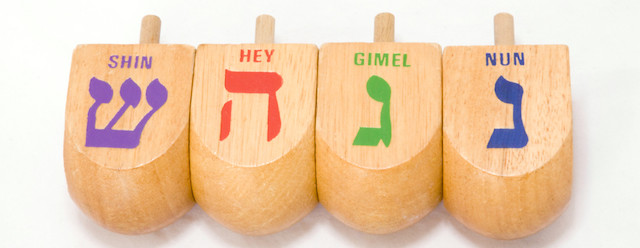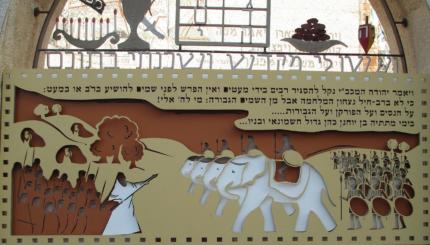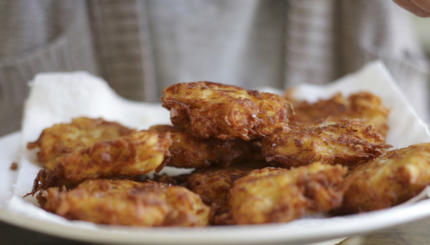The dreidel or sevivon is perhaps the most famous custom associated with Hanukkah. Indeed, various rabbis have tried to find an integral connection between the dreidel and the Hanukkah story; the standard explanation is that the letters nun, gimmel, hey, shin, which appear on the dreidel in the Diaspora, stand for nes gadol haya sham–“a great miracle happened there,”while in Israel the dreidel says nun, gimmel, hey, pey, which means “a great miracle happened here.”
One 19th-century rabbi maintained that Jews played with the dreidel in order to fool the Greeks if they were caught studying Torah, which had been outlawed. Others figured out elaborate gematriot [numerological explanations based on the fact that every Hebrew letter has a numerical equivalent] and word plays for the letters nun, gimmel, hey, shin. For example, nun, gimmel, hey, shin in gematria equals 358, which is also the numerical equivalent of mashiach or Messiah!
Finally, the letters nun, gimmel, hey, shin are supposed to represent the four kingdoms that tried to destroy us [in ancient times]: N = Nebuchadnetzar = Babylon; H = Haman = Persia = Madai; G = Gog = Greece; and S = Seir = Rome.
As a matter of fact, all of these elaborate explanations were invented after the fact.
With your help, My Jewish Learning can provide endless opportunities for learning, connection and discovery.
The dreidel game originally had nothing to do with Hanukkah; it has been played by various people in various languages for many centuries.

In England and Ireland there is a game called totum or teetotum that is especially popular at Christmastime. In English, this game is first mentioned as “totum” ca. 1500-1520. The name comes from the Latin “totum,” which means “all.” By 1720, the game was called T- totum or teetotum, and by 1801 the four letters already represented four words in English: T = Take all; H = Half; P = Put down; and N = Nothing.
Our Eastern European game of dreidel (including the letters nun, gimmel, hey, shin) is directly based on the German equivalent of the totum game: N = Nichts = nothing; G = Ganz = all; H = Halb = half; and S = Stell ein = put in. In German, the spinning top was called a “torrel” or “trundl,” and in Yiddish it was called a “dreidel,” a “fargl,” a “varfl” [= something thrown], “shtel ein” [= put in], and “gor, gorin” [= all].
When Hebrew was revived as a spoken language, the dreidel was called, among other names, a sevivon, which is the one that caught on.
Thus the dreidel game represents an irony of Jewish history. In order to celebrate the holiday of Hanukkah, which celebrates our victory over cultural assimilation, we play the dreidel game, which is an excellent example of cultural assimilation! Of course, there is a world of difference between imitating non-Jewish games and worshiping idols, but the irony remains nonetheless.
Reprinted with permission of the author from A Different Light: The Hanukkah Book of Celebration published by the Shalom Hartman Institute and Devora Publishing.
Explore Hanukkah’s history, global traditions, food and more with My Jewish Learning’s “All About Hanukkah” email series. Sign up to take a journey through Hanukkah and go deeper into the Festival of Lights.
dreidel
Pronounced: DRAY-dul, Origin: Yiddish, a spinning top, with four sides, each marked with a different Hebrew letter (nun, gimel, hay and shin), it is played with on Hanukkah.
gematria
Pronounced: guh-MAH-tree-yuh, Origin: Greek, a numerological system by which Hebrew letters correspond to numbers, used in Jewish mysticism as a way of interpreting Jewish texts.
Hanukkah
Pronounced: KHAH-nuh-kah, also ha-new-KAH, an eight-day festival commemorating the Maccabees' victory over the Greeks and subsequent rededication of the temple. Falls in the Hebrew month of Kislev, which usually corresponds with December.



